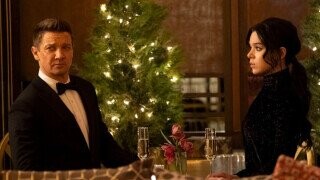Why ‘Hawkeye’ Had To Be Set At Christmas

After six weeks of trying to make everybody finally like everyone's least-favorite Avenger, Marvel's Hawkeye wrapped up with an epic Die Hard-esque finale set, not at Nakatomi Plaza, but at 30 Rockefeller Plaza – sadly, there was no scene in which Lorne Michaels personally takes on the Tracksuit Mafia while wielding a broken chardonnay bottle.
As we suspected might be the case, this last episode featured a ton of references to iconic Christmas movies, from Clint fighting gun-toting bad guys in a half-constructed office, à la John McClane, to him and Kate fashioning homemade weaponry on Christmas Eve, Kevin McCallister-style.

Marvel Studios

20th Century Studios
They even managed to squeeze a subtle Elf shout-out into the scene where Kate fights Yelena.

Marvel Studios

New Line Cinema
Setting Hawkeye at Christmastime wasn't just an excuse to cram the show full of Andy Williams songs and seasonal easter eggs; it was absolutely fundamental to the story being told. For one thing, Clint going full Murtaugh at the end of Lethal Weapon bringing Kate home to his place for Christmas instead of, say, hanging around for a few days to make sure she connects with her non-criminal family members wouldn't really make any sense at any other time of the year.
But more importantly, Christmas was the ideal setting for a show that was ultimately about Clint grappling with his past – specifically Clint's guilt after his best friend sacrificed her life for his, despite the fact that he had pivoted into the murder-happy ninja business. We've seen that many of these Marvel shows exist primarily to explore the deeper ramifications of the wacky events of the movies. Well, Hawkeye proved to be one of the best examples of this trend, taking time to explore how Clint would still be pretty messed-up following the events of Endgame, even though he thankfully ditched the faux-hawk and somehow resisted the urge to start his own self-aggrandizing vanity app.
Prior to Hawkeye, the only other Christmas-set MCU project was Iron Man 3, which similarly dealt with an Avenger's lasting trauma. Director (and famous Christmas obsessive) Shane Black once explained his fascination with the holiday, stating that "Christmas represents a little stutter in the march of days, a hush in which we have a chance to assess and retrospect our lives."
It's that same theme of assessment and retrospection that drives Hawkeye. Looking back at the show as a whole, it's clear that it owes less to the lighter holiday fare most obviously being referenced and more to some of the heavier yuletide tales, like Dickens’/Gonzo the Great's classic story A Christmas Carol. Sure, Hawkeye isn't a 19th-century miserly dickhead, but he sure has a lot of past sins to atone for. And like with Ebenezer Scrooge, Clint's moral reckoning is kicked off by a glimpse of a ghost from his past; not Jacob Marley, but Ronin – or at least Kate wearing the Ronin costume. He's also forced to endure the pain of witnessing past events from his life in the form of the lavish Avengers-themed musical Rogers, not unlike how Scrooge travels back in time to gawk at his younger self..

Marvel Studios

Renown Pictures

Marvel Studios

Renown Pictures
Like some of the best Christmas stories, Hawkeye was very much about a guy being confronted with his past, including his regrets and his shame. This recalls the existential crises of not only Scrooge but also It's a Wonderful Life's George Bailey, who briefly made an appearance earlier in the series.
In the end, Clint is able to shed his past regrets, on Christmas Day no less, by barbecuing the hell out of the Ronin suit. Of course, he also could have turned himself in to the authorities for all of those unsolved murders he committed, but sure, you do you, Clint.
You (yes, you) should follow JM on Twitter!
Top Image: Marvel Studios